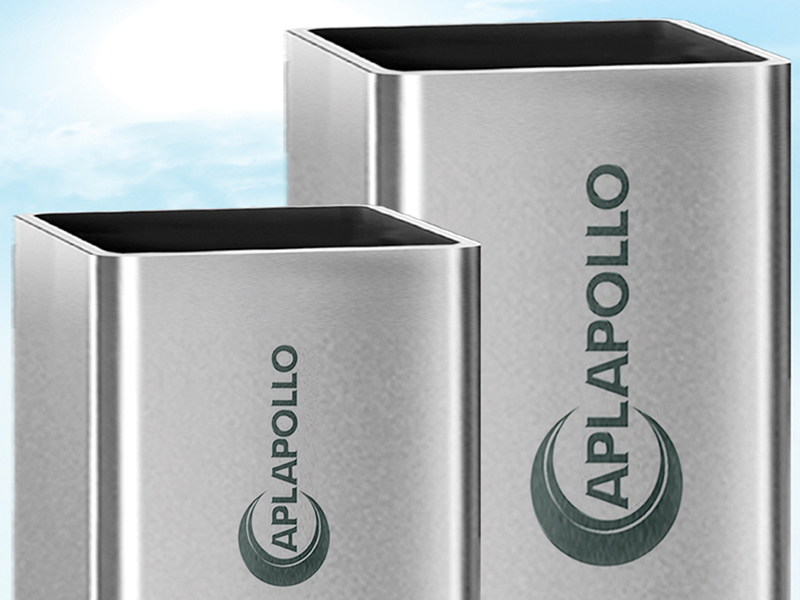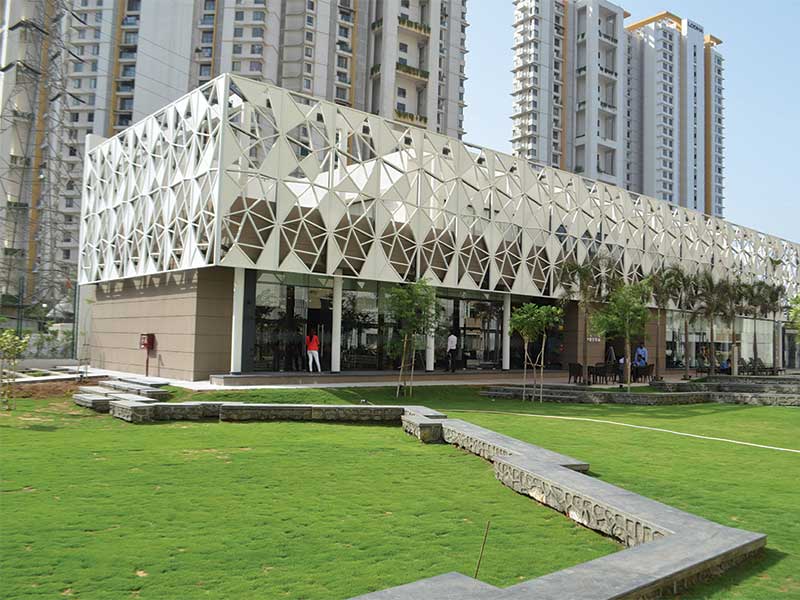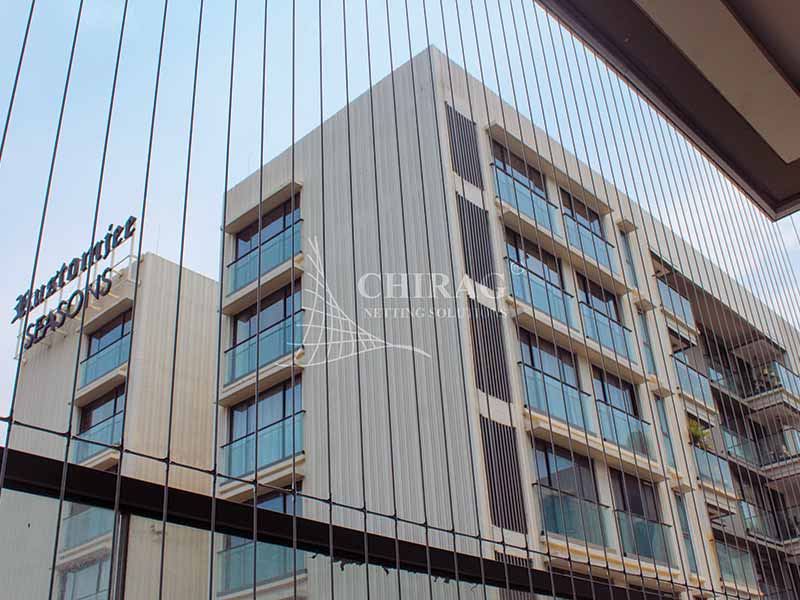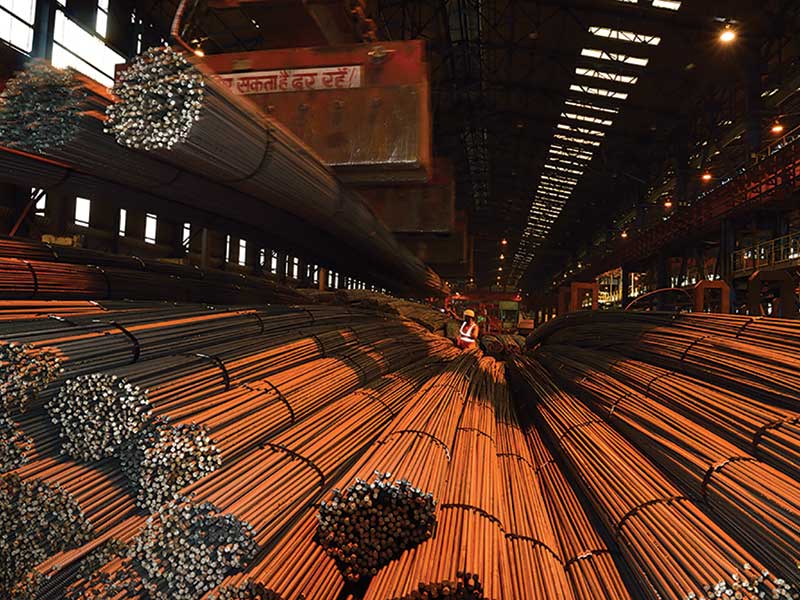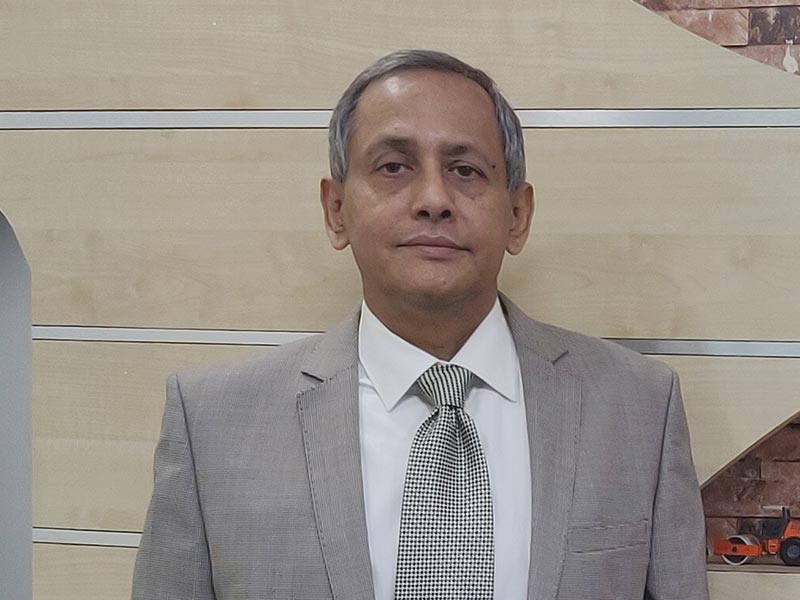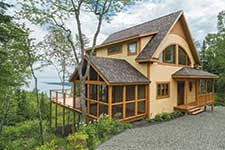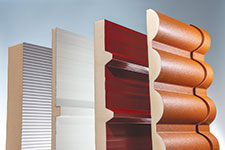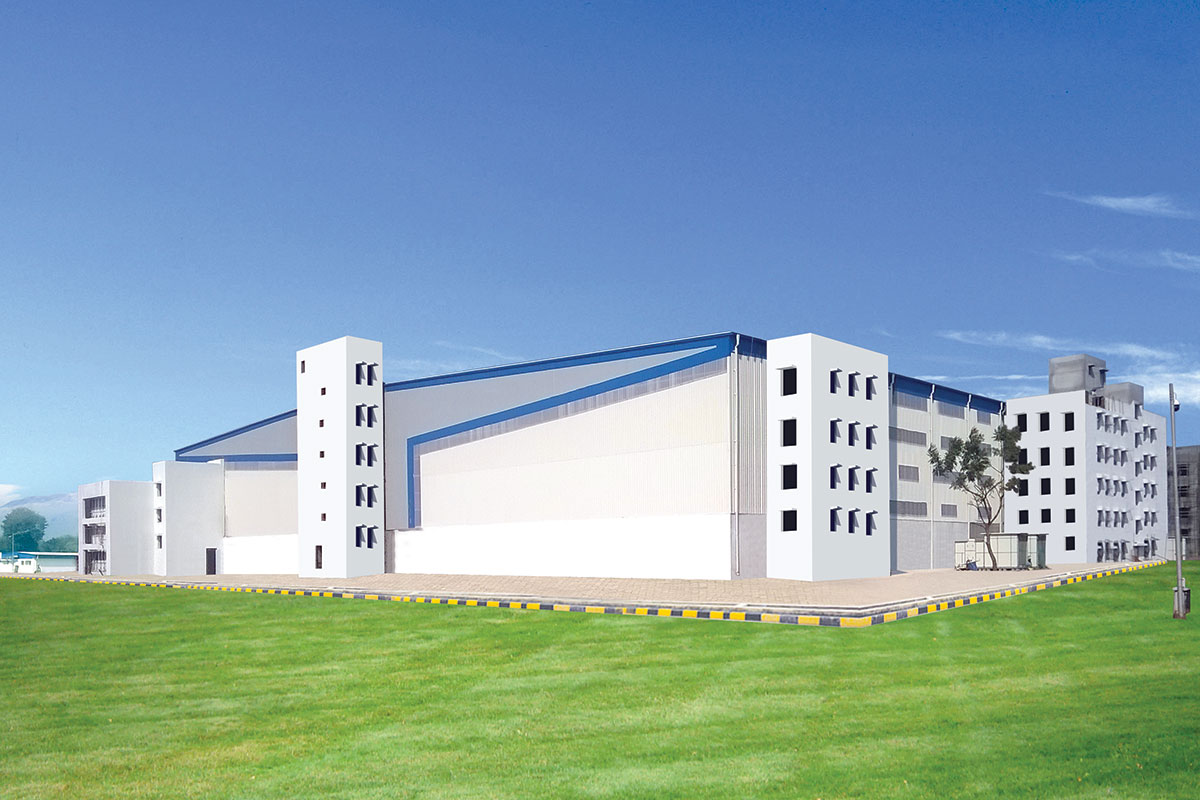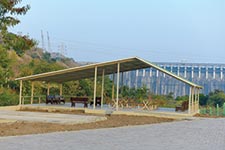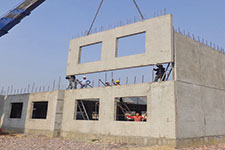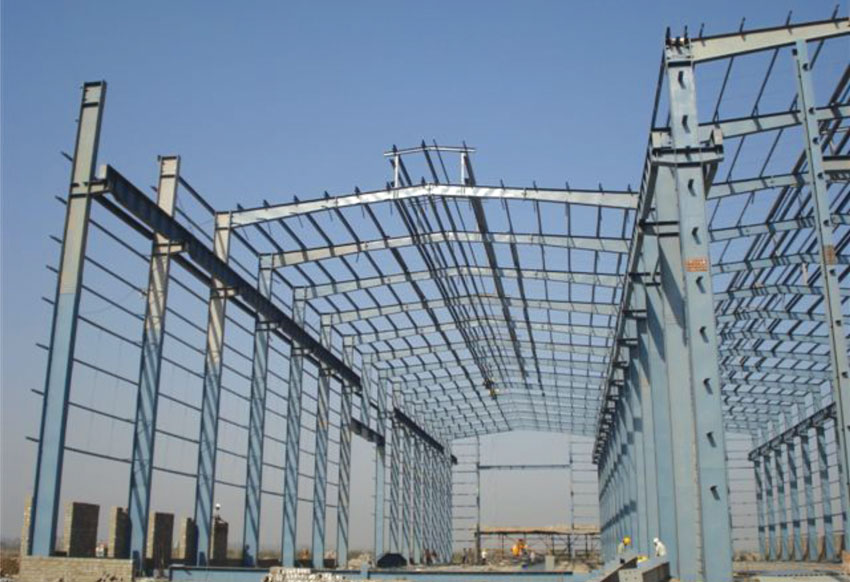
PEB: A New Technological Wave
Technological improvement over the year has contributed immensely to the enhancement of quality of life through various new products and services. One such revolution was the pre–engineered buildings. Though its origin can be traced back to 1960's, its potential has been felt only during the recent years.An estimated 70% of all new commercial buildings in the US are pre-engineered! There is really no dispute in the fact that pre-engineered building systems are the new wave in construction.
Definition

Pre–engineered means, generally speaking, is any part of a structure that is manufactured prior to its arrival on the building site. The concept of the pre-engineered building (PEB) is one where the fabrication is completed in a controlled environment with the latest technology, and then subsequent erection is carried out.
Though initially only off the shelf products were available in these configurations aided by the technological development tailor made solutions are also made using this technology in very short durations.
The designs were ready-made but the building components were either ready-made or manufactured against specific orders. These buildings were pre-designed or 'pre-engineered' into standard sizes, spans, bays and heights, and use standard details for fixing cladding, roofing, gutters, flashing, windows, doors etc taking advantage of industrial practices of mass production of components economically.
Although PEB systems are extensively used in industrial and many other nonresidential constructions worldwide, it is relatively a new concept in India. These concepts were introduced to the Indian markets in the late 1990's with the opening up of the economy; and a number of multi–nationals setting up their projects. The current pre–engineered steel building manufacturing capacity is 6.0 lac ton per annum. The industry is growing at the compound rate of 25 to 30%.
With respect to design of the structure and aesthetic appearance India is way behind. Indian manufacturers are trying to catch up; comparatively PEB is a new concept in India.
A healthy trend in the form of growth in demand for construction works in residential, Commercial, Institutional industrual and infrastructure sectors are being seen over the past decade. Modern Structures are much more complex and sophisticated as compared to earlier period. One of the major changes which are being felt by all is that the present structures are taller and thinner. Modern day requirement of structures is that these should be lighter yet not compromising on functionality. Civil engineering construction has seen a continual economic competition between steel, concrete and other construction materials.
Currently, the total steel production in the country is about 45Mn Ton against 1280Mn ton of world. Per capita steel consumption in India is 42kg whereas it is 270kg in China. About 10% of steel goes to the construction industry and amidst it PEB accounts only for the 0.5Mn ton. As on date. In the next 5 years, the steel production will be doubled and with efforts of organisations like BIS and INSDAG, steel intensive construction may rise up to 22Mn ton. Owing to advantages of PEB, several non-conventional segments are also getting attracted to use PEB and the potential will rise up to 2.2Mn ton which is four to five times of today's scenario.
Subsequent paragraphs are only a humble attempt to present the various aspects of conceptual development, technology of design and manufacture; and future growth aspects of Pre–engineered building Industry in India along with its grey areas.
The Concept: Superiority of PEB over Conventional Construction
Pre–engineered steel buildings use a combination of built-up sections, hot rolled sections and cold formed elements which provide the basic steel frame work with a choice of single skin sheeting with added insulation or insulated sandwich panels for roofing and wall cladding. The concept is designed to provide a complete building envelope system which is air tight, energy efficient, optimum in weight and cost and, above all, designed to fit user requirement like a well fitted glove.These Pre–engineered Steel Buildings can be fitted with different structural accessories including mezzanine floors, canopies, fascias, interior partitions, crane systems etc. The building is made water-tight by use of special mastic beads, filler strips and trims. This is a very versatile building system and can be finished internally to serve any required function and accessorized externally to achieve attractive and distinctive architectural styles. It is most suitable for any low-rise building and offers numerous benefits over conventional buildings.
It is very advantageous over the conventional buildings and is really useful in case of the low rise buildings. Pre-engineered buildings are generally low rise buildings; however the maximum eave heights can go up to 25 to 30 meters. Low rise buildings are ideal for offices, houses, showrooms, shop fronts etc. The application of pre-engineered concept to low rise buildings is very economical and speedy. Buildings can be constructed in less than half the normal time especially when complimented with other engineered sub-systems. Table-1 presents an overview of comparison between RCC, Conventional steel and PEB structures.
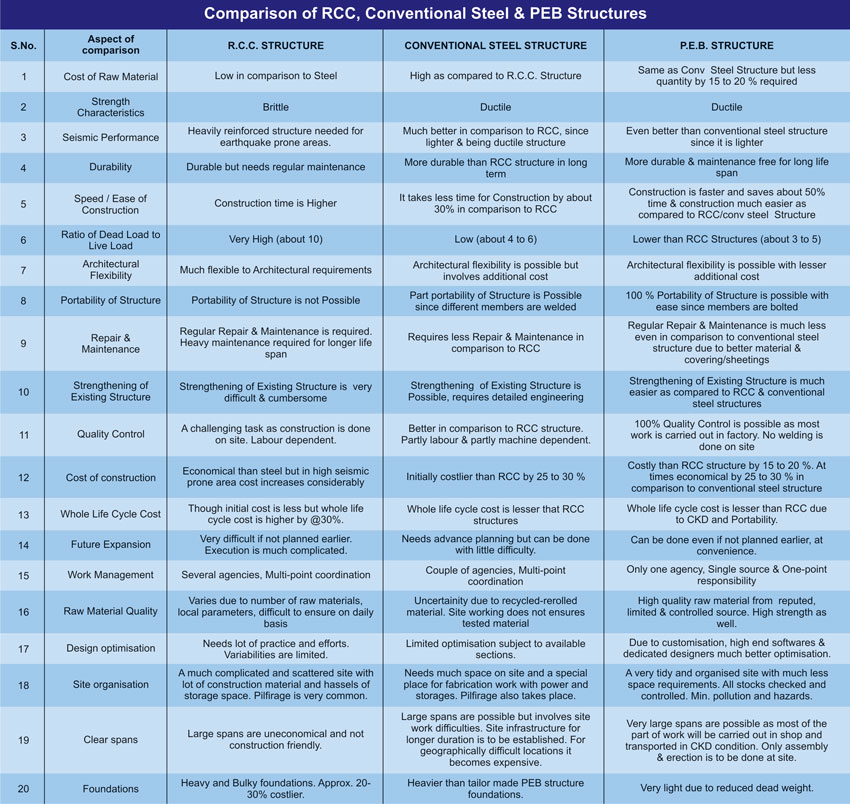
Good structural design of the building necessitates integration of the structure into a whole physical system. It is necessary to understand the influence of structural design on the architectural design and also vice versa for the development of the subsystems for power, lighting, thermal control, ventilation, water supply, waste handling, firefighting etc. The steel structural systems have come out more popular largely because of their ability to provide flexibility in accommodating these subsystems in the building while allowing architectural forms.
Apart from the state of the art technology used for fabrication of pre-engineered buildings, the other main difference is in the assembling of PEB. The varied components of the PEB are joined to each other based on the nut and bolt methodology as against the welding and riveting methodology used for conventional steel buildings. Metal building technologies permit almost complete freedom to the designer and the architect in incorporating whatever features may be needed in the building-structural, thermal, ventilation or acoustical, to name a few.
Advantages
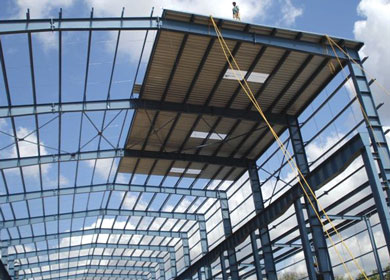
Apart from costs, there is an assurance of factory-built quality and uniformity in design and fabrication. These systems are also energy efficient; incorporate watertight roofing systems; enable easy disassembly or future expansion and have the lowest life cycle maintenance costs.
Adding to these; there is no mess of sand and cement; power savings; walkable ceilings; progressive and non-progressive panel systems for walls. A poor man can be provided with a home created under strict quality control and having a longer life span, with greater safety against natural disasters like earthquakes and cyclones.
Moreover, It is possible to create the building in required form and shape. And the 'system approach' renders a holistic way of thinking at one platform for consultants, designers, architects, and builders. Thus it tends to achieve a perfect harmony among various stringent specifications and aesthetic requirements in a most economic way.
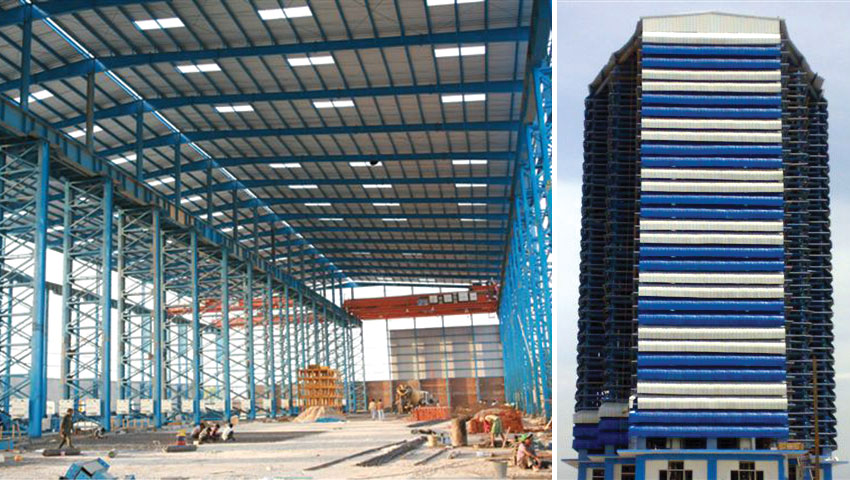
In nutshell, the benefits may be summarized as under:
- Increased speed of construction, quicker return on investment
- Ensured quality of material, Design and construction
- Unlimited architectural possibilities
- Enhanced Durability and seismic reliability
- Easy construction, maintenance and refurbishing
- Increased Life cycle performance and cost competitiveness
- Environment–friendly structures
- Better value for money
- Cleaner and unencumbered sites
- Sustainability in construction through reuse of most materials
- Suitability for Hilly regions and other geographically difficult areas
- Hassle Free
- Optimized design of steel reducing weight
- Better Earthquake & Wind pressure resistant.
- Energy efficient roof and wall system using insulations.
- Easy integration of all construction materials
- The building can be dismantled and relocated easily.
- Future extensions, expansion modification can be easily accommodated without much hassle.
- Faster delivery and erection, saving around 30-40% of project time
- Column-free large spans, up to 90 m.
- Virtually maintenance free
- Single-source responsibility
- 'Systems approach' ensures integrity and safety of all building components
- Lighter weight; savings in foundation cost of 10-20 percent
- Insulated from sound and heat, as per the requirement
- Better rainwater harvesting through gutters and down-take arrangements
- Overall economy
Diversified Applications
Almost every conceivable building use has been achieved with PEB; the most common applications are industrial, institutional and commercial.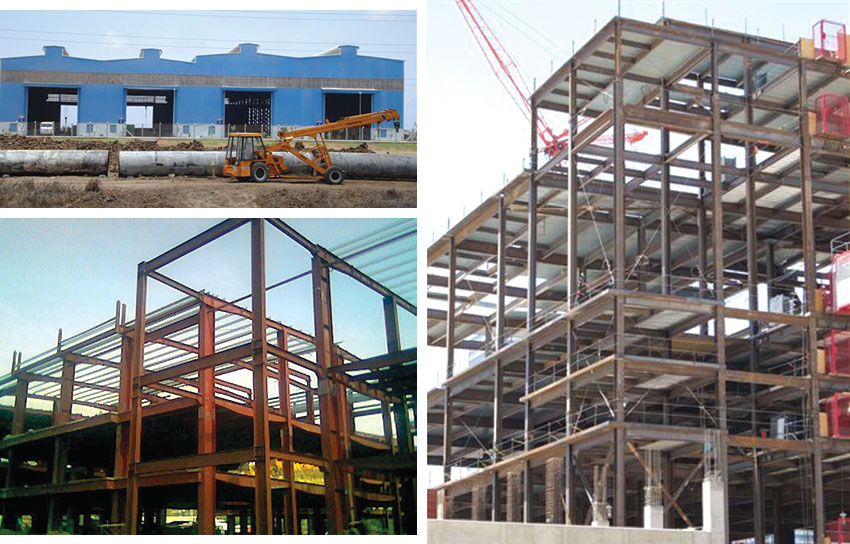
In India, Pre-engineered building systems find application primarily in the construction of Warehouses, & Industrial sheds & Buildings. The recent focus has also shifted to cover Rural as well as urban, individual and mass housing projects, farmhouses, slum re-organisation projects and rehabilitation projects, amenity structures like health centres, kiosks, primary schools, panchayat ghars etc. The pharmaceutical industries and exhibition centres, and functional requirements like offices, seminar halls, call centres, supermarkets, showrooms etc. have also attracted PEB. Earthquake-resistant buildings are the recent applications of PEB with wide and immediate acceptance.
PEB concept has acted as a catalyst in the infrastructure development of the country. Single storied houses for living take minimum time for construction and can be built in any type of geographic location like extreme cold hilly areas, high rain prone areas, plain land, extreme hot climatic zones etc.
Applications of pre-engineered steel buildings include (but are not limited to) the following:
- Industrial Buildings & Workshops
- Warehouses
- Commercial Complexes & Supermarkets
- Showrooms
- Corporate Office Buildings
- Schools
- Indoor Stadiums
- Outdoor Stadiums with canopies
- Fuel Stations
- Metro Stations, Bus Terminals, Parking Lots
- Highrise Buildings
- Customized Housing
- Large Exhibition Centers
- And many more…
- Aircraft Hangers
- Labor Camps
- Community Centers
- Railway Stations & Railway Storage yards
- Equipment housing/shelters
- Telecommunication shelters
- "Almost" any low-rise building
Main Components
There are following major components in a pre-engineered building:- Primary or Main frame
- Gable End framing or Wind columns
- Secondary frame or Purlins, girts etc.
- Roof & Wall Sheeting
- Bracing system
- Crane system
- Mezzanine system
- Insulations
- Attachments like canopies, fascia etc
- Doors, Windows, Ventilators
- Accessories like Turbo vents, Ridge Vents, Skylights etc.
Main Framing

Main framing basically includes the rigid steel frames of the building. The PEB rigid frame comprises tapered/straight columns and tapered rafters (steel plate fabricated 'I' or 'H' sections are referred to as built-up members). The frame is erected by bolting the end plates of connecting sections together.
Secondary frame or Purlins, girts etc.
Purlins, girts and eave struts are also known as secondary cold-formed members. There is no welding involved in their preparation. They are prepared by press bending the HR steel coil giving it the desired shape(Z- or C-shape).Roof & Wall Panels
Metallic plain or color coated profiled steel sheets are used as roof and wall sheeting. The steel sheets are generally made from Zincalume or Galvalume coils in thickness range of 0.47mm to 0.55mm. The base steel is either galvanized having a zinc coating varying from a minimum Mass of 120 gsm./m2 to a maximum of 275 gsm./m2 (total of both sides) or a base steel coating of zinc – aluminum (zinc 45%, aluminum 55%) of total Mass of 150 gsm./m2 (total of both sides) are available with permanent color coating. The color coating is also available in various options in polyester paint coating like regular modified polyester, silicon modified polyester and super polyester coatings. Special organic coatings like PVF2 (Poly Vinyl Fluoride) are also made available. These various color coatings on the base steel with galvanized or zinc aluminum coating provides suitable resistance for various kinds of environment hazards. Metal roofing and siding profiles can be manufactured to any length – limited only by transportation constraints (usually to 12 meters). Lap joints with 150mm to 200mm overlap virtually eliminate water ingress.Profiling can be carried out at site itself with no limit in lengths. This permits a totally joint-less run of roofing, a major advantage to the designers to create roofing with the minimum pitch. Machines have been developed which permit rolling at the eaves level so that even the task of lifting and shifting the rolled profiles in to position is avoided. Standing seam profiles with a pre-determined height of up-stands can be chosen to accommodate the expected run-off of water without overflow on to the crest of the profile.
At the initial project planning stage, roof slope is a key consideration for architects incorporating roof systems into their designs. Slopes as shallow as 1:20 are possible ensuring sufficient drainage of water and good long term performance of roof panels.
These profile steel sheets are usually categorized into two types depending upon the type of fixing arrangement followed. These two types are known as Through Fastened and second one is Standing Seam.
Installation of this type of roofing & cladding system can provide 30 years or more of trouble-free service in most environments.
Insulations
These buildings can be properly insulated by providing fibrous insulation slabs/rolls of non-combustible Rockwool, Aluminum foil laminated, placed over a metal mesh bed created between the purlins, and then the roofing steel sheet fixed over it. The siding walls can also be insulated by providing a double skin profile steel sheet wall cladding having Rockwool Insulation slab sandwiched in between and held in position with the help of 'Z' spacers in between the two profile steel sheets. In similar pattern a double skin insulated roofing system can also be erected.Sandwich Panels
Another alternative is to provide pre-fabricated insulated panels, which comprises two single skin panels (plain steel sheets zincalume color coated) with polyurethane foam insulation in between. These panels are intended for use as thermally efficient roof and wall claddings for buildings e.g., in high altitude areas and cold storages. In addition to the above sandwich panels also find extensive use in residential as well as non-residential buildings. The panels provide sufficient insulation and noise reduction properties. Nowadays large cold storage units (Potato, Onion, vegetables, processed foods etc.) are also made with this pre-engineered building technique.Crane systems
These pre–engineered buildings can be equipped with Overhead EOT cranes, Semi-gantry cranes, wall mounted cranes, Mono rails and under slung cranes for various material and equipment handling operations inside. These buildings are being designed for crane capacities ranging from 1MT to 250MT. The crane runway beams (Gantry Girders) are simply supported built-up sections with/without cap channels and with maintenance platforms and ladders. Catwalks for crane maintenance are usually mounted alongside the crane beams, suspended under rigid frame rafters or elevated above the top of the building roof. Cranes at various levels can also be provided. PEB vendors generally do not keep the supply of rail and Crane Bridge with crane in their scope.Mezzanine systems
Standard mezzanine structure consists of built-up beams that support built-up, hot-rolled or cold-formed mezzanine joists which in-turn support a metal deck. A concrete slab is cast on the metal deck as a finished surface. Steel checkered plates may also be used as top surface. These mezzanines are used for office space, storage or equipment supports in industries. For commercial buildings and highrise structures several types of light weight panel boards are available as horizontal surface.Bracing system
Longitudinal cross bracing, used to provide lateral stability to the structure against wind, seismic or other forces, comprises of rods, pipes, angles or cables with an eye bolt and an adjusting nut at both ends, located near the outer flange of columns or rafters and attached at the web of the rigid frame.Paints and finishes
Any desired finish can be achieved as per the architect/client recommendations. Various choices are synthetic enamel or epoxy based paints, depending upon the environment inside and outside the building.Accessories, Attachments etc.
As per the functional and architectural requirements, accessories are supplied in ready to fit condition. Ventilation and lighting systems should be properly designed in consultation with an expert.High Strength Materials
The standard mild steel used in civil engineering construction have nominal yield stress values of approximately 250MPa but the PEB industry is using high tensile hot rolled steel plates and coils of 345MPa. Recent revision of IS2062:2006 has incorporated these high tensile grades of steel for structural uses and there are a good number of manufacturers like TATA, SAIL, etc. who are manufacturing these in India. The new materials like Fe540B gives yield stress as large as 410MPa in plate thickness lower than 20mm. the galvalume or zincalume roofing and wall sheets have strengths in the range of 550MPa. Steel became more popular in design and construction of larger structures as well structures with unusual geometry due to its large strength to weight ratio, viability of economical fabrication, and ease of erection.A typical sample of material specs for a PEB project, as defined and freezed in advance is enclosed for ready reference. This indicates that the client is assured of the quality of material that is being supplied.
The design Process & Principles
Pre-engineering of metal buildings can be optimized to meet specific design criteria. Largely Indian and American practice of design is followed by most of the consultants and PEB vendors in India these days. A brief of design codes used in each of these is attached herewith:PEB Design Process in Brief
The Load calculations are done as in the case of a regular frame. Normally, the critical case governing the designs would be (DL+WL) or (DL+LL) conditions as the PEB slopes are minor (like 1 in 10). The support conditions are normally hinged, but it is some times beneficial, on a selective basis to use a fixed condition giving a gussetted base plate and Anchor bolt combination. In Hinged base condition, the section is normally tapered down and provided with a Bolted connection to the base. All the other Joints would be normally designed as rigid joints and steel connections are moment connections, transferring the axial, moment and shear values between the sections connected. In the Wind load calculations, the design wind pressures should be arrived at after a careful analysis and combinations of internal and external pressure coefficients or force coefficients, referring to IS-875 pt.3 latest version. Proper load combinations with Wind, Earthquake and Crane loads should be investigated.Any standard structural analysis and design software can be employed for PEB designs, like STAAD etc. However, couple of good dedicated software is also available for PEB like MBS, Precision Plus etc. Since detailing and connectivity of various components is much more important, owing to CKD nature, it is good to use a high end detailing software that also has a BIM capability, like TEKLA Structures, which provides a complete integration of complete analysis, design, detailing, Bill of material preparation and production/dispatch/erection planning.
Usually, Checking the Combination Stresses and comparing with the limiting values (in LSD or WSD) is done using interactive software, which calculates the Exploitation efficiency of the section, i.e., if the Actual Stress/permitted stress is 0.95, it means that the section is exploited for 95% of its strength. For this, the total weight of the frame is calculated. A no. of trails are done such that sections are designed with Variables like Flange thk, Web thk, Flange Width, Web Depth, so that the Entire frame becomes theoretically safe, and is of minimum wt! Checking for defections is the next step. Many times sections need to be revised to hold the theoretical maximum deflections within the permissible ones. Some Vendors exploit 90% of the section, leaving 10% for probable lapses in manufacturing, transporting, assembling & erection. But the competition has made (forced) people believe that there are no lapses anywhere! The Next important step is to design the welds between the flanges and Webs. Here too, Efficiency of the weld plays an important part. Hence, PEB manufacturer will avoid any weld at the site, because a 4.5 mm weld at the shop may be better than 6 or 8 mm weld at the site.
Next step is to design the Field joints (Where the parts are assembled at the site). The resultant forces are known at the joints; design a bolted connection, preferably perpendicular to the plane of frame, to exploit tensile capacity of bolts for BMs rather than the shear capacities. Hence, Number of bolts required for the connection will reduce. These joints are also placed at Optimum locations! That is the advantage of pre engineering.
The secondary members like Purlins and Girts are designed as per codes for thin Cold Formed Sections, with or without lip. One can use many span reducing and Lateral supporting techniques like sag rods and knee bracings, tie rods to optimize the sections.
Some issues in PEB Design trend in India
While the Analysis of any Structure would be universal, designs need to be done as per the local/ regional codes. Otherwise why different countries have different codes of Practice? For example, if a PEB is built in India, The load calculations need to be as per the latest IS 875, the designs need to be as per IS800 for main frame members, as per IS 801 for thin rolled secondary members (Z and C purlins and Girts). If a country does not have a code, the building may follow the UBC or the code of a country near by IF suitable.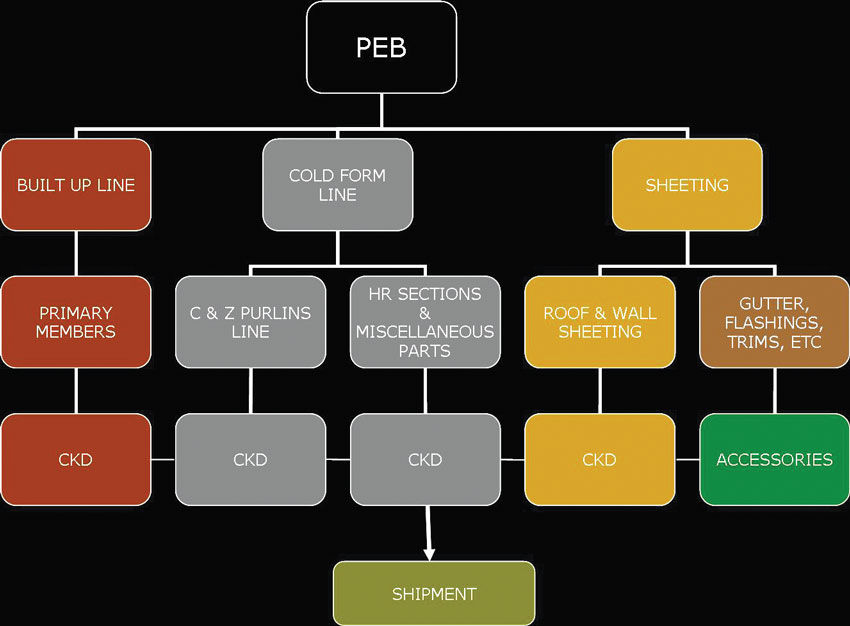
To make the superstructure most economical and very competitive, most of the PEB vendors select the codes as per THEIR requirement. For example, for a structure built in India, they might calculate the loads as per IS 875, but do the design as per AISC or AISI, MBMA and use welds as per AWS. If they feel that the Steel Section is lighter as per one code, they will adopt THAT clause of the code and select another clause of another code of another country for the design of some other part of the same building. Some PEB vendors select some clauses of previous versions of the Code and other clauses of the Latest Versions! This style is not the same every time. PEB Design teams are on constant research in the Selection of Codal provisions of various countries and are on trials with different clauses.
The evolution of a Code of Practice is based on the Weather & other climatic conditions, Material, Local Practices, Skill levels at manufacturing, Transporting, Assembling, erecting, finishing and maintaining. Hence it is ridiculous to use Indian Steel plate of any yield stress, Cut and manufactured in India, Loaded & transported in Indian Style, Unloaded and stacked in Indian Style, Assembled & erected by Indian (skilled) Labour, Finished by Indian Painters using Indian paints, Maintained by Indian Client in an Indian Town or village BUT DESIGNED USING AMERICAN CODE..! Several clients, structural engineers, Architects and consultants in India have a myth that American Codes are Better than Indian!
This way of varied design is legally not valid. If the loads and Codes are not specified by the buyer, it should be on the PEB supplier to use the Local/ Regional Codes of practice.
To conclude, Clients, Architects and Engineers in India, Beware! The Pre Engineered Buildings are not a New Concept. But the Jumping-Code-Practice is the NEW Concept and STYLE. If you are not sure of the Codes, DO NOT SIGN a Purchase order just copying the Specifications given by the PEB Vendor. Just mention somewhere that the Latest Revisions of Indian Standard Codes should be followed. Luckily, India has all the codes available for the design of all the Parts of a PEB structure.
High Engineering Production/Erection Process
The PEB production process primarily consists of FOUR major parallel processing lines, as under:- Built-up members for Primary frame
- Cold forming for Secondary framing
- Profiling for Roof and Wall sheeting
- Accessories & Bracings like Gutters, down take pipes, ridge Vents, Skylights, clips etc.
The production & shipment of these components for a PEB structure uses following processes:
- Plate cutting using Shear/Plasma/Multi-torch through nesting software for optimized use of plate area.
- H-beam welding on automatic welding machines using SAW or MIG welding process
- Fabrication for fitments like end plates, stiffeners and connections cleats.
- Cleaning the surface for painting
- Slitting HR coils for cold forming operations to make Z and C sections with punching
- Cutting and threading sag rods and bracing rods
- Fabrication of Diagonal bracing angles or pipes
- Profiling the Galvalume/Zincalume sheets for roofing and wall cladding
- Manufacturing Gutters, down take pipes in press bend
- Procuring and assigning required matching fasteners for connections
- Organizing some bought out accessories
- Quality control tests & inspection; and matching with project wise Bill of Quantities as given by the engineering department.
- Dispatching to project sites as per sequence of erection
Erection
Steel framing members are delivered at site in pre-cut sizes, which eliminates cutting and welding at site. Being lighter in weight, the small members can be very easily assembled, bolted and raised with the help of cranes. This system allows very fast construction and reduces wastage and labour requirement. These buildings can then be provided with roof decking and wall cladding with metal profile sheets and proper insulation. The framing are so designed that electrical and plumbing services are part of it and can be very easily concealed.However, the erection process is highly technical and needs skilled and trained manpower to handle heavy construction equipments. Proper training of erection engineers for understanding of drawings and execution of work is necessary. A qualified and experienced work agency should be employed for erection work.
Grey Areas: Points of Concern: What Glitters is not always GOLD…????
The evolution of the application of steel in civil engineering practice gives rise to many issues from the point of view of engineering design, research and development of steel structures.Issues of Concern
- Fire protection
Although great advances have been made in lighter and more economical fire protection systems but fire protection remains an issue of greater concern for steel structures than compared to concrete or other construction materials. The smaller members and thermal mass associated with steel structures makes it more vulnerable. The memories of collapse of world trade centre towers in USA due to fire caused by burning of aviation fuel and sudden rise of temperature leading to complete destruction of structure might not have faded away. Fire protection adds up to larger part of structural cost. It would be a challenge to engineers toward reducing these costs, while assuring adequate resistance to elevated temperatures expected during a fire. - Buckling
Buckling and stability become more critical in Steel structures due to smaller members and large stress levels. - Micro Cracks
The increasing yield stress, operating stress levels, emphasis on plastic and ultimate capacity, and use of welded construction have resulted in increased frequency of initiation of micro cracks and cause of fracture in bridges and industrial structures. Further development of Micro Cracks and crack growth become a major concern in areas of seismically vulnerable areas. - Corrosion
Steel has great tendency to corrode when exposed to the environment, which leads to deterioration, increased maintenance costs, and increased reconstruction costs. Although Galvanization, paint, and coatings may provide protection against corrosion, yet they increase the overall fabrication costs of the steel structure appreciably. In hot and humid regions and industrially polluted severe environments problem is more pronounced. Therefore, engineers have to continually seek economically viable solutions to aim at reducing these costs. - Welding
Presently welded constructions are more commonly used, for these provide stiffer, stronger structures with reduced building weight. Increased steel yield strength requires new innovative welding methods, because high strength steels pose more difficulty to weld without affecting adversely the ductility and performance of the structural system. Recently the use of fully automatic and semi-automatic submerged arc welding results in increase in welding speed apart from the good quality. The elimination of any fumes, smoke or any visible arc column gives an ease of operation and efficiency; better quality & thus encourages its application in welding industry. - Ductility from seismic considerations
Seismic design is today a must requirement for almost all civil engineering structures. Although steel is an ideally more suited material from point of view of seismic design because of its property inherent material strength, stiffness, and ductility. Weldability may affect the seismic performance and it follows that new methods to improve inelastic seismic performance of steel structures need to be investigated.
Meliorations
Critics point to poor aesthetics with a typical 'industrial' or 'warehouse' look; minimal flexibility regarding location, shape and size of structural members; the need to utilise off the shelf building shapes and sizes in order to realise cost savings; and a lighter structure which does not achieve the longevity of more conventional structural systems."The most basic prerequisite of PEB is 'single sourcing' of the entire building. Any slight deviation from this can deprive the customers of the real advantages. Also, as steel is prone to corrosion, it would require various protective coatings which may sometimes make PEB unfeasible economically."
Maintenance
In PEB the maintenance area is the steel roofing & cladding. Installed roofing must be inspected at least once a year. Any exposed metal that can rust or has rusted should be painted. Leaves, branches, and trash should be removed from gutters, at ridge caps and in corners. Also watch out for discharge from industrial stacks, and particulate matter and high sulphur exhaust from space heaters which could get piled up.The Future Bright Towards the Economic growth
Steel is a preferred material for construction, due to its various advantages like quality, aesthetics, economy and environmental conditions. This concept can have lot of scope in India, which can actually fill up the critical shortage of housing, educational and health care institutions, airports, railway stations, industrial buildings & cold storages etc.Pre-engineered Metal building concept forms a unique position in the construction industry in view of their being ideally suited to the needs of modern Engineering Industry. It would be the only solution for large industrial enclosures having thermal and acoustical features. The major advantage of metal building is the high speed of design and construction for buildings of various categories.
The present construction methodology for buildings calls for the best aesthetic look, high quality & fast construction, cost effective & innovative touch. One has to think for alternative construction system like pre-engineered steel buildings. India has an installed steel capacity of 35 to 40 million ton & apparent steel consumption is around 27 to 30 million ton. In pre-engineered building concept the complete designing is done at the factory and the building components are brought to the site in knock down condition. These components are then fixed / jointed at the site and raised with the help of cranes.
PEB concept has been very successful and well established in North America, Australia and is presently expanding in U.K and European countries. PEB construction is 30 to 40% faster than masonry construction. PEB buildings provide good insulation effect and would be highly suitable for a tropical country like India. PEB is ideal for construction in remote & hilly areas.
They are the only answer to the backlog of 33 million houses required in India alone, provided that the system offers quality, economy, and speed together. The building system is developed considering all aspects of building requirements and simultaneously offers technological advancement to all sections of society.

Recent Innovations
- High performance steels (HPS)
- Fire-resistant steels:
- Steels with increased ductility
- Corrosion resistant steels
- Concrete filled steel tubes (CFT)
Future Trends
In this era of competition it is increasingly important to build more economical structures, which provide good integrated system performance. Steel is basically better suited for bigger, taller, and longer span and geometrically complex structures, as a result, steel is likely to be predominantly used for many years into the future. Increased economy in civil engineering construction is achievable through higher strength steel, composite form of construction and improved materials therefore engineering community is more akin to use steel structural systems in the future and it is felt that this trend will continue. Engineers will need to develop suitable Codes and specifications for the purpose to meet the requirements of future generations. There is increased invest more for research and development for innovative material and construction methodologies.One has to use the PEB products, with a word of caution, and frame the contract provisions accordingly. We are fairly close to a day when steel buildings should be the rule, rather than being the exception, if we work together to give the Client, best value for his money.
